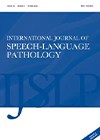You searched for "Ear Institute"
Therapeutic alliance: more than the ‘nice person’ effect
3 November 2023
| Anna Volkmer
|
ENTA - Speech and Language Therapy
Therapeutic relationship is considered a key component of many healthcare interventions, including speech and language therapy. Yet definitions and descriptions of what this concept comprises are ambiguous and sparse. This scoping review used the Joanna Briggs Institute guidelines to guide...
Lymph node ratio is a significant predictor for loco-regional recurrence after neck dissection in patients with papillary thyroid cancer
1 July 2018
| Shabbir Akhtar
Lymph node metastases are common in papillary thyroid cancer (PTC), yet the impact of nodal metastases on survival remains unclear. Lymph node density (LND) is the ratio between the number of positive lymph nodes excised and the total number of...
Above and beyond interprofessional learning
1 May 2018
| Anna Volkmer
There has been a significant focus on interprofessional education for all health professionals over recent years. The American Speech-Language-Hearing Association became a member of the Interprofessional Education Collaborative (IPEC) competencies (in America) in 2016. These competencies provide four core competencies...
Are we now safe at work?
3 September 2024
| Jennifer K Stott
|
ENTA - Audiology - Adult, ENTA - Audiology - Diagnostic, Otology, ENTA - Tinnitus, ENTA - Vestibular Disorders
Fifty years is a long time, yet the years pass in a blink of an eye. Where are we in comparison to where we were then, in terms of the occupational protection from noise exposure and ototoxicity, other than being...
Hearing aid standards and test systems
Hearing aids are the most used management / rehabilitation option for people with hearing loss. Generally, hearing instrument manufacturers perform the hearing aid performance measurements and provide its specification in terms of functionality. However, it is also common for government...ENT emergencies
1 January 2015
| Sunil Sharma
|
ENTA - ENT
This Belgian paper reports the epidemiology of 1296 patients attending the emergency department with ENT problems over a five-year period. As expected the most common presentation was epistaxis, but interestingly vertigo seemed to be the second most common presentation to...
Shifting paradigms – how a visionary can change a specialty
The Tarabichi-Stammberger Ear and Sinus Institute came about because of a close working relationship and friendship between two senior figures in the specialty. Professor Muaaz Tarabichi tells us the story. My first meeting with Heinz Stammberger was in 1988 in...Otologic Surgery - 5th Edition
Otologic Surgery 5th Edition, edited by Derald Brackmann, Clough Shelton, Moises Arriaga and Richard Gurgel, is a textbook masterpiece. The book is written in tribute to the editors’ mentors: Drs Howard House, William House and James Sheehy, whose pioneering work...Risk factors for post tonsillectomy bleeds
1 November 2014
| Ravi Thevasagayam
|
ENTA - Skull Base Surgery, ENTA - Head & Neck
|
Bleeding, Postoperative hemorrhage, Reoperation, Tonsillectomy
This paper reviews post-tonsillectomy bleeding in 692 patients and attempts to tease out risk factors. The overall bleed rate of 11.6% seems very high. The return to theatre rate was 2.6%. The paper identifies male patients and adult patients as...
Leadership in academia
1 September 2014
| Hisham Mehanna (Prof)
|
ENTA - ENT
I went into medicine with the clichéd view of wanting to help people. I found that by doing surgery I could help a small number of people, albeit usually to a large effect. Then, I recognised that by engaging in...
Ida Institute telecare tools help teens take charge of their hearing healthcare
1 January 2017
| Ena Nielsen
|
ENTA - Audiology - Diagnostic, ENTA - Audiology - Paediatric, ENTA - Audiology - Adult
In this article Ena Nielsen from the Ida Institute discusses new ways to put teens in the driver’s seat of their hearing healthcare needs. The teenage years can be a challenging time for any young person. When hearing loss is...
A multidisciplinary approach to the management of the adult balance - dizzy patient
30 April 2020
| Richard E Gans, Kimberley Rutherford
|
ENTA - Vestibular Disorders
Richard Gans and Kimberly Rutherford, renowned experts from The American Institute of Balance, give their team’s overview of the stages involved in reaching ‘diagnosis based strategies’. For the dizzy patient, this focuses on patient-centred clinical pathways for individualised therapy with...











